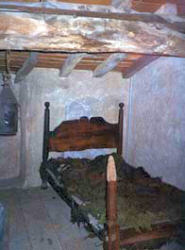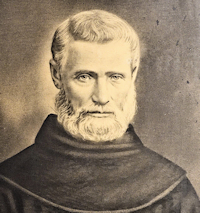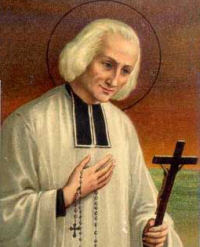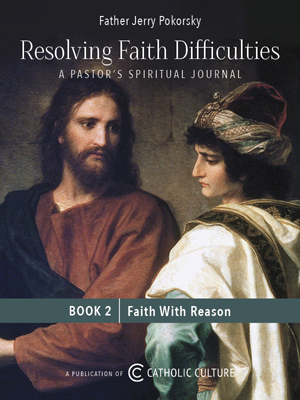Ordinary Time: August 4th
Memorial of St. John Vianney, priest; Blessed Frédéric Janssoone OFM (Canada)
Other Commemorations: Bl. Frederic Janssoone, OFM, Priest (RM) ; Other Titles: Curé d'Ars
» Enjoy our Liturgical Seasons series of e-books!
St. John Baptist Mary Vianney (1786-1859) was born in Dardilly and died in Ars, France. Although his talents were limited and his education meager, he was ordained a priest in 1815. After three years at Ecully, he was appointed parish priest of Ars. Here he spent almost forty-two years of his life, devoting himself to prayer, mortification, and pastoral works. His success in directing souls made him known throughout the Christian world. Men of all ranks and conditions of life sought his guidance and advice. He was beatified by Pope St. Pius X, himself once a parish priest, and canonized by Pope Pius XI.
According to the 1962 Missal of St. John XXIII the Extraordinary Form of the Roman Rite, today is the feast of St. Dominic. St. John Vianney's feast is on August 8. St. Dominic's feast in the Ordinary Form of the Roman Rite is celebrated on August 8.
Today is the feast day of Blessed Frédéric Janssoone, a Franciscan priest who was born in France, served in the Holy Land, and died in Canada. He initiated a spiritual renewal in Canada based on meditation on the suffering and passion of Christ.
St. John Vianney
 During the French Revolution a small band of Ursuline nuns was imprisoned in the Bastille. To cheer her disconsolate companions, one of the group passed wheaten discs of bread, cut from the loaf of the daily rations, to memorialize the happy days when they were free and could receive Our Lord in Holy Communion. At that time all religious schools and churches were closed, and those who harbored priests were imprisoned.
During the French Revolution a small band of Ursuline nuns was imprisoned in the Bastille. To cheer her disconsolate companions, one of the group passed wheaten discs of bread, cut from the loaf of the daily rations, to memorialize the happy days when they were free and could receive Our Lord in Holy Communion. At that time all religious schools and churches were closed, and those who harbored priests were imprisoned.
At the Vianney farmhouse near Dardilly, France, fugitive priests were offered a refuge. Here their son was prepared in his tenth year for the reception of Holy Communion by a hunted priest.
While tending his father's sheep, John Vianney fashioned a small statue of Our Lady out of clay. He hid it in the hollow of an old tree with this petition: "Dear Lady Mary, I love you very much; you must bring Jesus back to His tabernacles very soon!"
On a visit to his aunt at Ecully, John listened to her praises of Father Balley, the parish priest, and he sought the Father's advice regarding his vocation to the priesthood. The pastor appraised the overgrown, awkward youth of faltering speech and devoid of general education. Though John was unable to answer the questions pertaining to earthly science which Father asked him, yet, when the priest put to him the questions of the catechism, his face became luminous with lively interest. He answered every question correctly, and in a manner beyond his years. The amazed pastor took this evidence as a sign from heaven, prophesying, "You will become a priest!"
The ensuing years brought many trials to John. He was conscripted; his mother died; he failed often in his studies. Ordained as a Mass priest, August 12, 1815, he remarked to Our Lady, Queen of the Clergy: "Here is your priest, O Blessed Mother! Stay close to me. Help me to be a good priest!"
As a curate and as a pastor, St. John Vianney's daily instruction on the catechism found an inspired audience, among whom were noted orators such as Père Lacordaire, O.P., the famed preacher of Notre Dame. The saintly pastor performed many miracles, but the greatest was his own manner of Eucharistic living. It was his Lord, living in Father Vianney, who made him "spend and be spent" in ceaseless service for both sinner and saint in the sacred tribunal of penance.
—Rev. Vincent F. Kienberger, O.P.
Patronage: confessors; Personal Apostolic Administration of Saint John Mary Vianney; parish priests (proclaimed on 23 April 1929 by Pope Pius XI); all priests (proclaimed by Pope Benedict XVI during the year of priests); archdiocese of Dubuque, Iowa; diocese of Kamloops, British Columbia; archdiocese of Kansas City, Kansas; diocese of Lafayette, Louisiana; archdiocese of Saint Paul and Minneapolis, Minnesota
Symbols and Representation: Cassock, surplice, preaching bands, stole, rosary, crucifix, and a Bible
Highlights and Things to Do:
- The Collect praises St. John Vianney's zeal for souls and his spirit of prayer and penance. Say a special prayer today that by his example and intercession we too may win the souls of our brothers for Christ.
- See Catholic Culture's special section dedicated to the Curé d'Ars for the Year of the Priests, 2009-2010.
- Say a prayer for priests that they may persevere in their vocation.
- From the Catholic Culture library: Pope John XXIII holds St. John Vianney as a model for the priesthood in this Encyclical Sacerdotii Nostri Primordia (On St. John Vianney).
- June 19, 2009—June 19, 2010, was The Year for Priests declared by Pope Benedict XVI, which held St. John Vianney in particular prominence and example, and he was proclaimed as patron saint of all the priests of the world. Although some links are no longer present, see Catholic Culture's special section for the Year for Priests.
- Read more about St. John Vianney:
- Visit Works of God for excerpts from St. John's sermons.
- St. John Vianney's relics are located in the Sanctuaire d’Ars (Sanctuary of Ars) in France.
- See Catholic Cuisine for feast day food ideas.
Bl. Frédéric Janssoone OFM
 Frédéric Janssoone was born on November 19, 1838, in the North of France. His mother was Flemish. His parents are devout and cultured people and give him a solid education. He loses his father on January 13, 1848, when he is only nine years old. Four years later Frédéric feels a call to priesthood and enters the Collège d’Hazebrouck, first, and then the Institution Notre-Dame des Dunes. In 1855, though, he has to leave school to look for a job to support his mother.
Frédéric Janssoone was born on November 19, 1838, in the North of France. His mother was Flemish. His parents are devout and cultured people and give him a solid education. He loses his father on January 13, 1848, when he is only nine years old. Four years later Frédéric feels a call to priesthood and enters the Collège d’Hazebrouck, first, and then the Institution Notre-Dame des Dunes. In 1855, though, he has to leave school to look for a job to support his mother.
After his mother’s death, in 1861, Frédéric was able to complete his studies. In 1864 he entered the novitiate of the Franciscans in Amiens. He was ordained a priest in Bourges on August 17, 1870, and took part in the foundation of the convent of Bordeaux and becomes superior of this community. In 1876 he is sent to Holy Land to be the assistant to the head guard of the Sacred Sites in Palestine. He helps with administration, promotes a renewal of the custom of Holy Land pilgrimages, reestablishes the ritual of the Way of the Cross in the streets of Jerusalem, and directs the construction of Saint-Catherine’s parish, next to the Church of the Nativity in Bethlehem. He revises the set of customary regulations that had developed through the centuries between the Latins, the Greeks and the Armenians for the use and maintenance of the shrines of Bethlehem and the Holy Sepulcher. He also is an excellent preacher.
In 1881 he makes his first trip to Canada to establish an annual fund-raising for the Holy Land. In 1888 he returns to Trois-Rivières where he founds the Commissariat for the Holy Land in Canada, that he will direct for 28 years. He preaches retreats and organizes pilgrimages to Saint-Anne-de-Beaupré, the Sanctuaire de la Réparation è Pointe-aux-Trembles and to Saint-Joseph’s Oratory in Montreal, where he meets and becomes a friend of Frère André. He dies of stomach cancer in Montreal on August 4, 1916. He was beatified by Pope St. John Paul II on September 25, 1988.
—Excerpted from the Canadian Religious Conference
Patronage: Secular Franciscan Regional Fraternity of Eastern Canada
Highlights and Things to Do:
- See the website dedicated to Frédéric Janssoone 1838-1916.
- See the Canadian Bishop's page about Blessed Frederic.
- Read more about Blessed Frédéric Janssoone:






